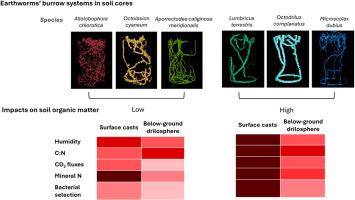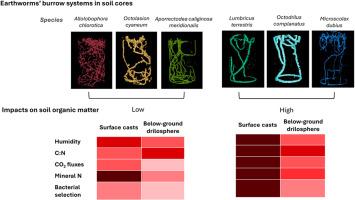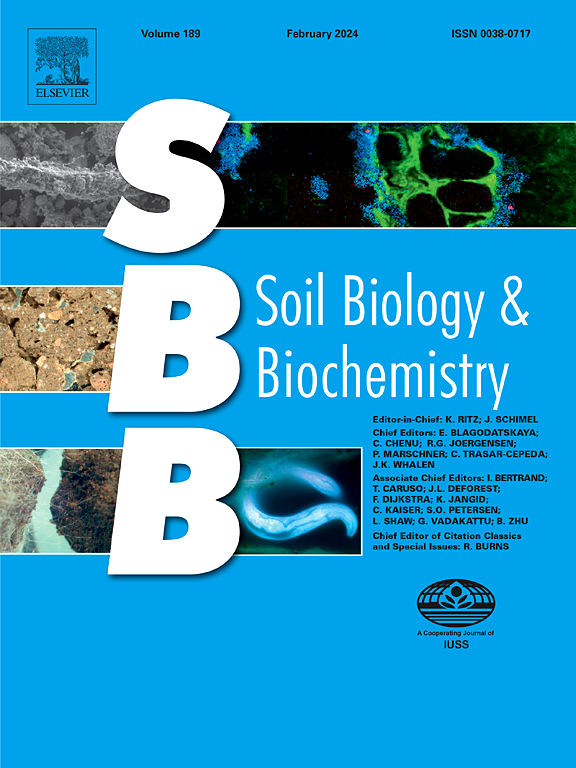The effects of earthworm species on organic matter transformations and soil microbial communities are only partially related to their bioturbation activity
IF 10.3
1区 农林科学
Q1 SOIL SCIENCE
引用次数: 0
Abstract
Earthworms are pivotal in shaping soil ecological processes through their bioturbation activity and organic matter consumption. Earthworm species are known to have different impacts on soil structure, but only a small number of species have been studied so far, and few studies have examined how earthworms simultaneously affect soil functions. Here, we measured the impact of different earthworm species on soil structure (bioturbation function), carbon (C) and nitrogen (N) dynamics and the microbial community (organic matter transformation function), while exploring the links between these functions, across distinct soil compartments (surface casts, below-ground drilosphere, and bulk soil). Six earthworm species (Lumbricus terrestris, Allolobophora chlorotica, Octolasion cyaneum, Octodrilus complanatus, Aporrectodea caliginosa meridionalis and Microscolex dubius) of different ecological categories and functional groups were incubated in soil cores with soil and alfalfa litter for 6 weeks. Our results on the bioturbation function illustrated a great diversity of behaviors and confirmed the relevance of a functional classification based on bioturbation metrics. The main microbial hotspots were surface casts, whose characteristics allowed to distinguish two groups of species. Octod. complanatus, L. terrestris and M. dubius induced high humidity (respectively, +57, +48, +74%), high C (respectively, 19.9, 24.8, 33.2 g kg⁻1 dry soil) and N (respectively, 2, 2.3, 3.2 g kg⁻1 dry soil) content and microbial community selection, promoting C and N mineralization. The three other species had a lower impact. The below-ground drilosphere only showed specific characteristics in the case of L. terrestris. The effects of the studied species on the organic matter transformation function did not align with their bioturbation activities nor with their ecological category. These findings show that the contribution of earthworms to C and N turnover is only partially dependent on their bioturbation effects and suggest the usefulness of developing distinct functional groups based on the specific soil functions under consideration.


蚯蚓物种对有机物转化和土壤微生物群落的影响与其生物扰动活动只有部分关系
蚯蚓通过其生物扰动活动和有机物消耗在塑造土壤生态过程中起着关键作用。众所周知,蚯蚓物种对土壤结构有不同的影响,但迄今为止只研究了少数物种,很少有研究探讨蚯蚓如何同时影响土壤功能。在这里,我们测量了不同蚯蚓物种对土壤结构(生物扰动功能)、碳(C)和氮(N)动态以及微生物群落(有机物转化功能)的影响,同时探索了这些功能在不同土壤区系(表层蚯蚓、地下蚯蚓圈和块状土壤)之间的联系。我们将不同生态类别和功能群的六种蚯蚓(Lumbricus terrestris、Allolobophora chlorotica、Octolasion cyaneum、Octodrilus complanatus、Aporrectodea caliginosa meridionalis 和 Microscolex dubius)与土壤和苜蓿废弃物一起放入土芯中培养 6 周。我们对生物扰动功能的研究结果表明了行为的多样性,并证实了基于生物扰动指标的功能分类的相关性。主要的微生物热点是地表菌落,其特征可以区分出两组物种。Octod. complanatus、L. terrestris 和 M. dubius 引发了高湿度(分别为 +57%、+48% 和 +74%)、高 C(分别为 19.9、24.8 和 33.2 g kg-1 干土)和 N(分别为 2、2.3 和 3.2 g kg-1 干土)含量和微生物群落选择,促进了 C 和 N 的矿化。其他三个物种的影响较小。只有 L. terrestris 的地下钻孔层表现出特殊的特征。研究物种对有机物转化功能的影响与其生物扰动活动和生态类别并不一致。这些研究结果表明,蚯蚓对碳和氮转化的贡献仅部分取决于它们的生物扰动作用,并表明根据所考虑的特定土壤功能建立不同的功能组是有用的。
本文章由计算机程序翻译,如有差异,请以英文原文为准。
求助全文
约1分钟内获得全文
求助全文
来源期刊

Soil Biology & Biochemistry
农林科学-土壤科学
CiteScore
16.90
自引率
9.30%
发文量
312
审稿时长
49 days
期刊介绍:
Soil Biology & Biochemistry publishes original research articles of international significance focusing on biological processes in soil and their applications to soil and environmental quality. Major topics include the ecology and biochemical processes of soil organisms, their effects on the environment, and interactions with plants. The journal also welcomes state-of-the-art reviews and discussions on contemporary research in soil biology and biochemistry.
 求助内容:
求助内容: 应助结果提醒方式:
应助结果提醒方式:


